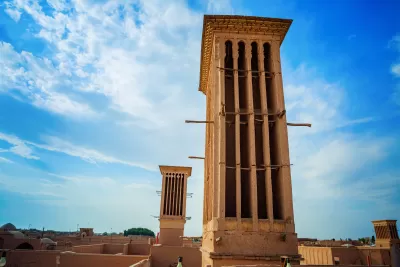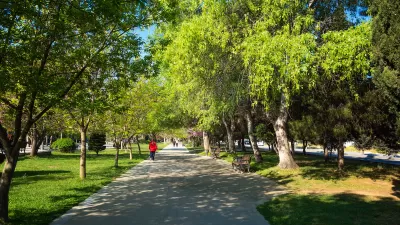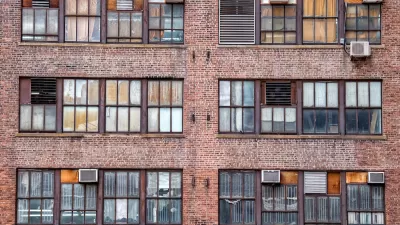Cooling mechanisms built into traditional architecture offer lessons for U.S. builders as heat waves grow more intense.

In an article in Time, Anna Gordon describes the centuries-old Middle Eastern architectural cooling techniques that could help U.S. households reduce their reliance on air conditioning, which “is believed to cause 1,950 million tons of CO2 emissions per year around the world, accounting for almost 4% of global carbon emissions.”
John Onyango, a professor at the University of Notre Dame School of Architecture, told Gordon, “Barajeels have passively cooled buildings for centuries. These wind towers can lower temperatures by up to 50 degrees Fahrenheit depending on how they are designed and the levels of wind.” These devices “work by funneling hot winds from outside to the lower floors of the building or even underground, where the air is cooled naturally. The cooled air is then released inside the building. So long as there is wind flowing, the barajeel works without ever requiring electricity.”
Other ways to improve air flow and cooling include chimney-like structures in tall buildings and high dome-shaped roofs. Gordon also points out the energy efficiency of many traditional Middle Eastern building materials. “Unlike the production process for steel or concrete, the production of stone and mud bricks does not lead to large amounts of carbon emissions.”
FULL STORY: The U.S. Should Ditch AC and Use Middle Eastern Techniques to Cool Its Cities

Maui's Vacation Rental Debate Turns Ugly
Verbal attacks, misinformation campaigns and fistfights plague a high-stakes debate to convert thousands of vacation rentals into long-term housing.

Planetizen Federal Action Tracker
A weekly monitor of how Trump’s orders and actions are impacting planners and planning in America.

In Urban Planning, AI Prompting Could be the New Design Thinking
Creativity has long been key to great urban design. What if we see AI as our new creative partner?

King County Supportive Housing Program Offers Hope for Unhoused Residents
The county is taking a ‘Housing First’ approach that prioritizes getting people into housing, then offering wraparound supportive services.

Researchers Use AI to Get Clearer Picture of US Housing
Analysts are using artificial intelligence to supercharge their research by allowing them to comb through data faster. Though these AI tools can be error prone, they save time and housing researchers are optimistic about the future.

Making Shared Micromobility More Inclusive
Cities and shared mobility system operators can do more to include people with disabilities in planning and operations, per a new report.
Urban Design for Planners 1: Software Tools
This six-course series explores essential urban design concepts using open source software and equips planners with the tools they need to participate fully in the urban design process.
Planning for Universal Design
Learn the tools for implementing Universal Design in planning regulations.
planning NEXT
Appalachian Highlands Housing Partners
Mpact (founded as Rail~Volution)
City of Camden Redevelopment Agency
City of Astoria
City of Portland
City of Laramie





























